The problem with the G train

Many words have been written about the G train, how it doesn’t go to Manhattan, how it doesn’t run frequently enough, how it runs with fewer cars that don’t span the long platforms so you have to run to catch it. Many people who live and work along the G train both loath and need the train at the same time. For all of its faults its still better than no train at all; it may take a while but you can transfer to another line at some point.
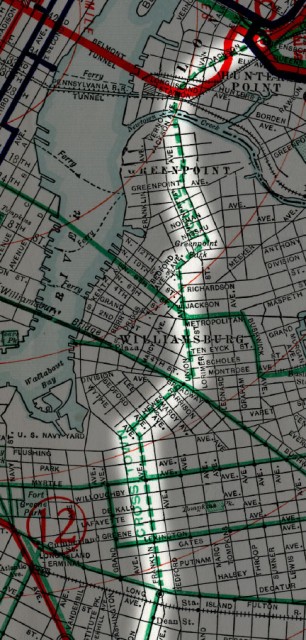
The problem with the G train is that it’s a compromise: when subways through Brooklyn and Queens were first being proposed a much more robust and interconnected subway was envisioned. As money and politics favored subways through Manhattan and into parts of Brooklyn the plans for a line connecting Queens and Brooklyn were whittled down from a network of loop-line subways that would have run into Manhattan to an elevated line running from Queens Plaza to Coney Island. This too was eventually rejected as Brooklyn residents wanted no new elevated tracks built.
What was eventually built, what we are left with today, is a collage of four different subway plans combined together, each with their own merits but together they don’t quite create a successful whole. Originally the G train ran from Smith-9th St in Red Hook to Forest Hills-71st Av. Even this was an odd routing as it meant that riders along the IND Queens Boulevard Line would always have to transfer from the local G train to an express E or F train if they wanted to get to Manhattan and riders along the IND South Brooklyn and BMT Culver Lines (today’s F train south of Jay St-MetroTech) would rather wait for a G train to pass to hop on a train to Manhattan.
The only sections that ran through new territory, those that ran through Bedford-Stuyvesant, Williamsburg and Greenpoint still required passengers to transfer to get to Manhattan. When first proposed a subway under Lafayette Ave in Brooklyn was meant to run into Manhattan but expansion plans were thwarted by the mayor who wanted, and eventually built, his own city-run subway (the Independent or IND). What is ever stranger is that no direct connection was built at the Hoyt-Schermerhorn station meaning that trains from Manhattan could never connect to the Crosstown Line’s tracks. This at least would have allowed a direct Manhattan-Lafayette Ave train service to run. The section of subway running north-south through Greenpoint and Williamsburg had originally been proposed to continue south all the way to Coney Island and north to the Queensboro Plaza station. The Franklin Ave Shuttle would have been taken over which would have provided a rapid transit link to Long Island City from anywhere in central Brooklyn. A direct connection to the Queensboro Plaza station could have provided for a crosstown line that could have terminated in midtown and thus removed the need for a final transfer.
Had any one of these different sections been designed to maximum potential it is conceivable that any crosstown service could have been a backup along routes that all ran into Manhattan. Oddly enough, much of the reason for the round about routing of the G train was due to Brooklyn boosters who convinced the powers that be that there would be a high demand for commuters between Queens and Brooklyn. This never materialized which led the city to eventually reroute more Queens Boulevard trains into Manhattan and sever the link that the G train offered between Queens and Brooklyn. Today the G train terminates at Court Sq where an oddly laid out transfer is required to get anywhere (a moving sidewalk gets you a block away to the 23rd St platforms of the E and M while a newly constructed headhouse allows a transfer to the 7 train. Had planners had more foresight the IND Queens Plaza station could have been designed to act as a terminal for crosstown trains but because it wasn’t the G train is left cut off from any convenient means of transfer.
Solutions
The MTA is well aware of the problems with the G train and given the growth over the last decade and the slim budget they have for new projects it must be noted that steps have been taken to make it better. Service has been extended south to Church St so that transfers can be made to the R train at 4th Av-9th St, the new headhouse and transfer at Court Sq was built so that an easier connection could be made to trains in Long Island City, and starting this week the MTA has increased service 25% at rush hour. All great first steps but I want to look further to see what can be done to transform the Crosstown Line. Development along the Crosstown corridor from Park Slope to Long Island City has been booming and even with a lull from the recession development seems to going faster than ever. More service will be needed and new connections made to ensure efficient use of the subways we have.
Queens Plaza Station
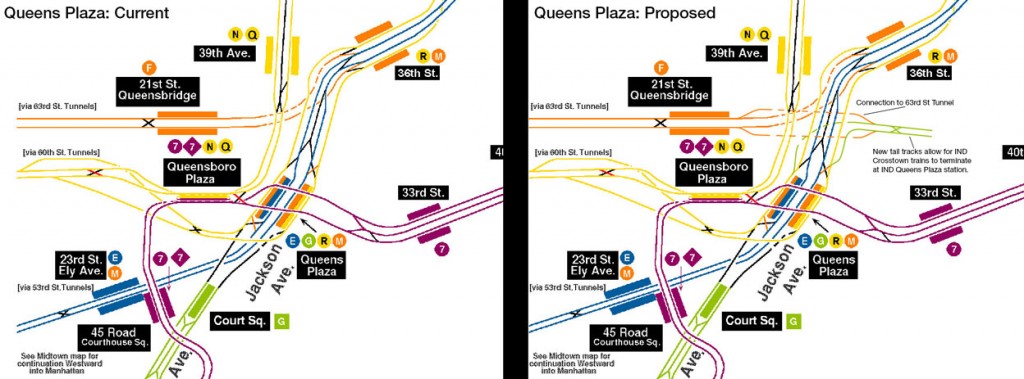
As I noted above the Queens Plaza station was never designed to be a terminal for Brooklyn-Queens crosstown trains. It was, in fact, designed to be a terminal for Queens Boulevard local trains with the idea that local trains would act as a feeder for the express trains and anyone looking to continue to Manhattan would transfer at Queens Plaza to the express trains to midtown. Commuter patterns turned out to prefer direct, one-seat rides rather than transfers even if this meant longer travel times and the crosstown-as-local service was supplanted by a direct connection to Manhattan via the BMT Broadway Line (today’s R train). This connection by itself was an improvement as riders now had three trains to Manhattan and one to Brooklyn. When the 63rd St tunnel was connected to the Queens Boulevard Line (F train) in 2001 service became complicated. The new connection meant that a fifth train (M train) was added to an already contested subway that provided additional local service to Manhattan. As the G train had the lowest ridership of the Queens Boulevard lines and was soon cut back to late night and weekend service. With budget cuts the line was cut back even further to the current terminal at Court Sq.
The Court Sq terminal is a problem because it leaves riders just short of the major transfer station and Queens Plaza. The MTA decided it was a better use of funds to construct an elaborate mega-station connecting the 23rd-Ely Av station of the E and M trains and the 45 Rd-Courthouse Sq station of the 7 train. While these stations are within a block of each other this still requires an inconvenient transfer. Terminating the G train at Queens Plaza would be preferred but due to the track layout doing so would back up service throughout the system as trains from the IND 8th Ave, 6th Ave, and BMT Broadway lines converge here (G trains would have to turn around by crossing ever set of tracks while all other trains waited).
A solution lies in the connection that caused this problem in the first place: the 63rd St tunnel connection to the Queens Boulevard subway between Queens Plaza and 36th St. When originally conceived the 63rd St tunnel was supposed to connect to a new subway running along the Long Island Railroad Main Line to Forest Hills to act as a superexpress line. Funding dried up after the tunnel under the East River was built which left the subway ending randomly at 21st Av in Long Island City. A connection was made to the Queens Boulevard Line cutting off the G train after Queens Plaza. What could be done is expanding the junction where the 63rd St tunnel meets the Queens Boulevard Line to allow for the local tracks off of Queens Plaza station to diverge and turn east to a new track yard with a connection to the 63rd St tunnel (see diagram above). This, combined with switching the F and M train routing, would allow space for crosstown trains to terminate at Queens Plaza while allowing local Queens Boulevard service to run to Manhattan either via 63rd St or the 60th St BMT Broadway Line tunnel. Riders would still have all options when commuting between Queens and Manhattan while on weekends (when the M train isn’t running) the F would be routed through the 63rd St tunnel as it is today. Additionally the new yard would be the connection needed to build the superexpress line out to Forest Hills if so needed.
Brighton Beach Branch

I’ve outlined this plan before, first in my Franklin Ave Shuttle post and then when I added it to my futureNYCSubway v2 and v3. The idea isn’t a new one, to use the vestigial Franklin Ave Shuttle to connect with the Crosstown Line and create a Queens to Coney Island subway. This was proposed a century ago when the Brooklyn-Manhattan Transit Co was expanding via the Dual Contracts. The plan was for an elevated line to slice a north-south path through Brooklyn and terminate at Queensboro Plaza. Local opposition killed the elevated idea and Mayor Hylan cut off the southern section when he had the IND build the Crosstown Line as it is today (I also speculate that the proposed Stuyvesant Ave/Utica Ave subway was meant to serve a similar purpose while depriving the BMT of passengers).
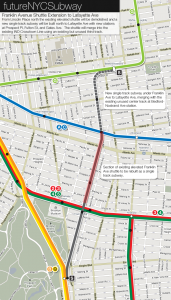
What would make a connection feasible is that between Classon Ave and Bedford-Nostrand Ave stations is space for a third track which was built at Bedford-Nostrand with a two track layup east of the station. In practice this third track is used for short turning trains while maintenance is done so that half the line can continue to operate (if only the L train was so lucky to have a third track!). Most transit historians will tell you that this third track was also built to allow for an extension of the subway under Lafayette Ave into Bushwick, something that was discussed in the IND Second System plan. While this is certainly a worthy expansion idea I feel that a much more useful plan would be to extend the third track west and then south under Franklin Ave to connect with the Franklin Ave Shuttle and then the main BMT Brighton Beach Line.
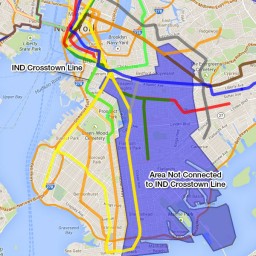
Such a connection would immediately address two problems with Brooklyn based transit: first it would give commuters from southern Brooklyn a much faster and less congested service to northern Brooklyn, Queens, and into Midtown by bypassing downtown Brooklyn and lower Manhattan (a Select Bus Service has recently been introduced along the Bedford/Nostrand Ave corridor from Sheepshead Bay to Williamsburg which illustrates the need for such an alignment), and second it would allow any commuter coming from eastern and southeastern Brooklyn a subway connection to northern Brooklyn (by which I mean if you are coming from East New York on the 3 train you can’t transfer anywhere to get to northern Brooklyn or LIC). As illustrated by the map to the left you can see that this is a large area of Brooklyn that cannot use the Crosstown Line. Even riders on the IND Fulton St Line have to first head into downtown Brooklyn before transferring to the IND Crosstown Line. A connection via the Franklin Ave Shuttle would literally open up new areas of Brooklyn to a quicker commute to Queens and reduce congestion in downtown Brooklyn and lower Manhattan.
An added benefit to a connection with the BMT Brighton Beach Line is that this additional crosstown service could run as a shuttle on nights and weekends should the traffic not warrant full service. The shuttle would go from the existing terminal at Prospect Park to Bedford-Nostrand and still provide commuters with a connection to northern Brooklyn.
Astoria Branch
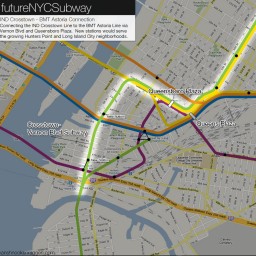
Adding a new southern branch of the Crosstown Line would allow for an additional northern branch as well. The current Crosstown Line terminates awkwardly at Court Sq making transfers to the IND Queens Boulevard Line difficult (I outlined above how this could be improved). A new branch would split from the current line under right after the Newtown Creek tunnels and head north under Vernon Blvd (the current subway veers northeast under Jackson Ave). Two new stations would serve the quickly developing Hunters Point and LIC neighborhoods before meeting with the BMT Broadway Line 60th St tunnel under Queens Plaza North. The interchange would be tricky as this is also the spot where the R train branches off to connect with the IND Queens Boulevard Line as well as where the subway begins its ascent to the elevated Queensboro Plaza station. Crosstown trains would then be able to have a direct connection to the Queensboro Plaza station as well as add a second train to the BMT Astoria Line out to Ditmars Boulevard.
At the Astoria-Ditmars Blvd end of the line I would recommend extending the elevated subway north into the ConEd territory north of 20th Ave. Here a small storage yard could be built as there is very little room left in the city for more storage yards and any expansion of this scope would require enough new trains that a new yard would be required. Additionally a new yard would be the staging ground for the proposed N train to LaGuardia.
Triboro-125th St
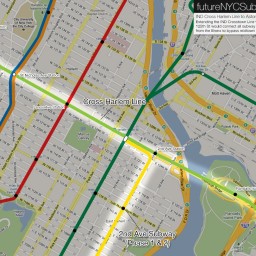
The final and costliest section of the Crosstown Line expansion would be to take the above mentioned Astoria branch and extend it into Manhattan via a new East River tunnel under Randalls Island into Harlem at 125th St. At 125th St the line would then be extended west to Broadway. Such an extension would also allow for the 2nd Ave Subway to be extended west as well giving Harlem two crosstown routes.
The benefits of such a connection would be huge for commuters from Harlem and the Bronx who must head into midtown before transferring to crosstown lines to the opposite sides of Manhattan or to get into Queens. Extending the Crosstown Line through Harlem would create a bypass around midtown Manhattan and relieve much pressure on some of the busiest stations in the entire system. This connection would allow commuters a faster ride to LaGuardia Airport as they would no longer need to slog along 125th St traffic on the bus and open up a faster commute for workers in the ever growing LIC residential and commercial areas.
Extending the Crosstown Line into Manhattan would open a world of opportunities for new commuting patterns and development for the city. These expansion ideas would also relieve pressure at choke points in downtown Brooklyn and midtown Manhattan that otherwise would be very expensive and disruptive to mitigate by expanding stations in these dense areas (look at how expensive the Fulton St station expansion has been).
Lafayette Ave Subway
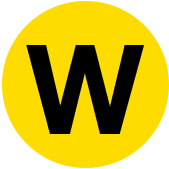
The final expansion plan would revisit one of the earliest proposed subways, one that the IND Crosstown Line co-opted, the Lafayette Ave subway. One of the first subways proposed in Brooklyn when the original 1904 subway proved successful, every subway company at the time tried to build it but the city stood in the way. When the first subway, the IRT, was extended into Brooklyn to Atlantic Ave a second level at Nevins St was partially built to allow for trains coming from lower Manhattan or across the Manhattan Bridge to connect with the subway and branch off under Lafayette Ave. When the BMT was building their subways through downtown Brooklyn space was left at DeKalb Ave to allow for a subway under Lafayette Ave. Once again it was Mayor Hylan who blocked these proposals and when the city designed the IND Crosstown Line under Lafayette Ave they purposely built it to cut off the IRT provisions (much like the urban legend of the 8th Ave-42nd St lower level station being built to block the IRT from extending the Flushing Line west).
Unfortunately the IND built the Lafayette Ave Subway in such a way that it would never enter Manhattan thus reducing its effectiveness. The IND built their system with the idea that passengers would use local subway lines in the boroughs and transfer to express trains that then entered Manhattan. They soon found this unpopular and local trains were soon routed into Manhattan when possible, though this was impossible with the Crosstown Line.
The two ways that Manhattan-bound trains could use the Lafayette Ave Subway would both require rebuilding already complex interchanges beneath downtown Brooklyn. The first would be to rebuild the IND interchange at Hoyt-Schermerhorn so that the IND Fulton St local tracks would branch off and connect with the IND Crosstown tracks before the Fulton St station. The other would be to branch off the BMT Brighton Beach tracks under Ashland Place and connect them with the IND Crosstown tracks. This second connection would prove even more challenging due to the Fulton St station at Fulton and Lafayette Ave which may have to be demolished to allow for this connection.
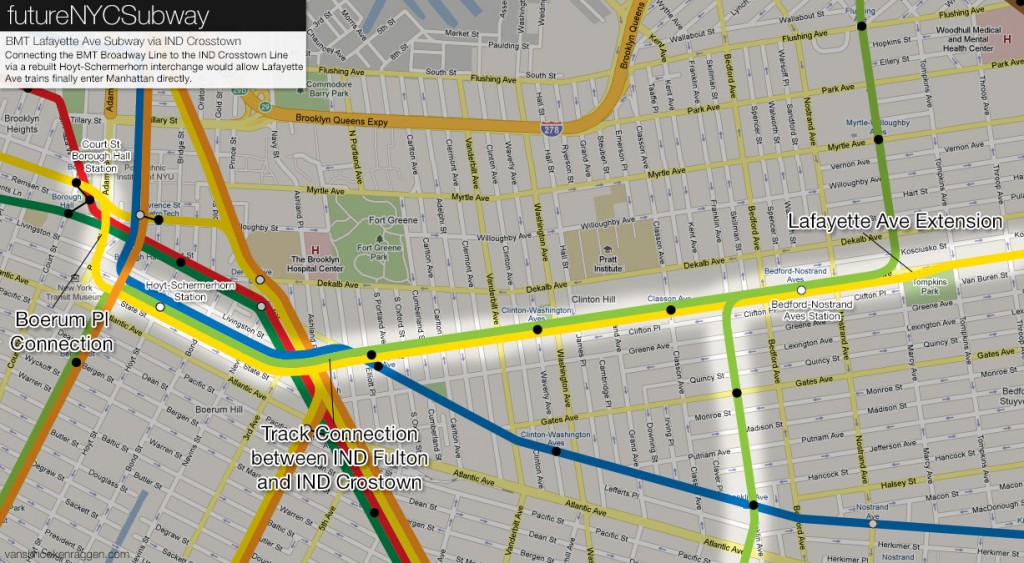
I would advocate for the first connection but it wouldn’t be so simple. Adding another local to the Cranberry St Tunnel (the tunnel that connects the IND 8th Ave and IND Fulton St lines) would cause congestion so to avoid this I would route a BMT Broadway local train via the Montague St tunnel. After Court St station a new connection would be made between the BMT and IND lines under Boerum Place. This connection would use the unused local IND tracks that lead to the New York Transit Museum which was a former IND Fulton St local station (originally planned for a local terminal like World Trade Center station on the IND 8th Ave Line). This would allow IND Fulton trains to access the BMT Broadway Line and with a connection to the IND Crosstown Line a way for Lafayette Ave trains to enter Manhattan finally. On the eastern end the Lafayette Ave Subway would be extended east into Bushwick where it could terminate or ascend to connect with the elevated BMT Myrtle Ave Line.
Going one step further a loop could then be created by connecting the IND Crosstown Line with the BMT Broadway Line in Long Island City as well by reversing the 11th St Connection, the subway which the R train uses to go from the BMT 60th St Tunnel to Queens Plaza station. Connecting the IND Crosstown Line to this so that crosstown trains could enter midtown along the BMT Broadway Line would mean that a loop line could run down Broadway and back into Brooklyn via the Crosstown Line. Such a loop would probably only be effective in the areas of Long Island City and central Brooklyn as commuters in Greenpoint and Williamsburg would still likely use the BMT Canarsie Line to access Manhattan. Still this would reduce the need for a certain percentage of transfers.
Crosstown Expansion vs Triboro Rx
A popular expansion plan that always seems to make the rounds is the Triboro Rx plan first outlined by the Regional Plan Association. The idea is to save money and expand transit into new areas by using existing freight railroad right of ways throughout Brooklyn, Queens, and the Bronx. The idea has its merits but I’ve never been a huge fan because it doesn’t seem to connect any places that need to be connected. The idea is more to save money than to improve transportation.
I would advocate that and of the plans for the IND Crosstown Line expansion that I’ve outlined here would be a better use of funds because it would rely on not just an existing ROW but also existing subway tunnels that are running below capacity. Expanding subways into new areas is something I fully support but with the limited funds available I would argue it is much more prudent to upgrade existing infrastructure for peak efficiency. Triboro Rx is a solution looking for a problem while expanding an existing subway line like the Crosstown for better connections and better service would do much more for the city while saving money.
It is unfortunately a bit of a Catch 22 as there are many other projects that need any available moneys more than the Crosstown Line. The 2nd Ave Subway is still years away from opening Phase 1, never mind when Phased 2-4 will see the light of day. The city is growing at a pace not seen in a generation and more importantly so are the neighborhoods through which the IND Crosstown Line runs. The demand is growing and expanding service along the Crosstown Line should be a higher priority than it is so far and certainly higher than the flashy Triboro Rx line.

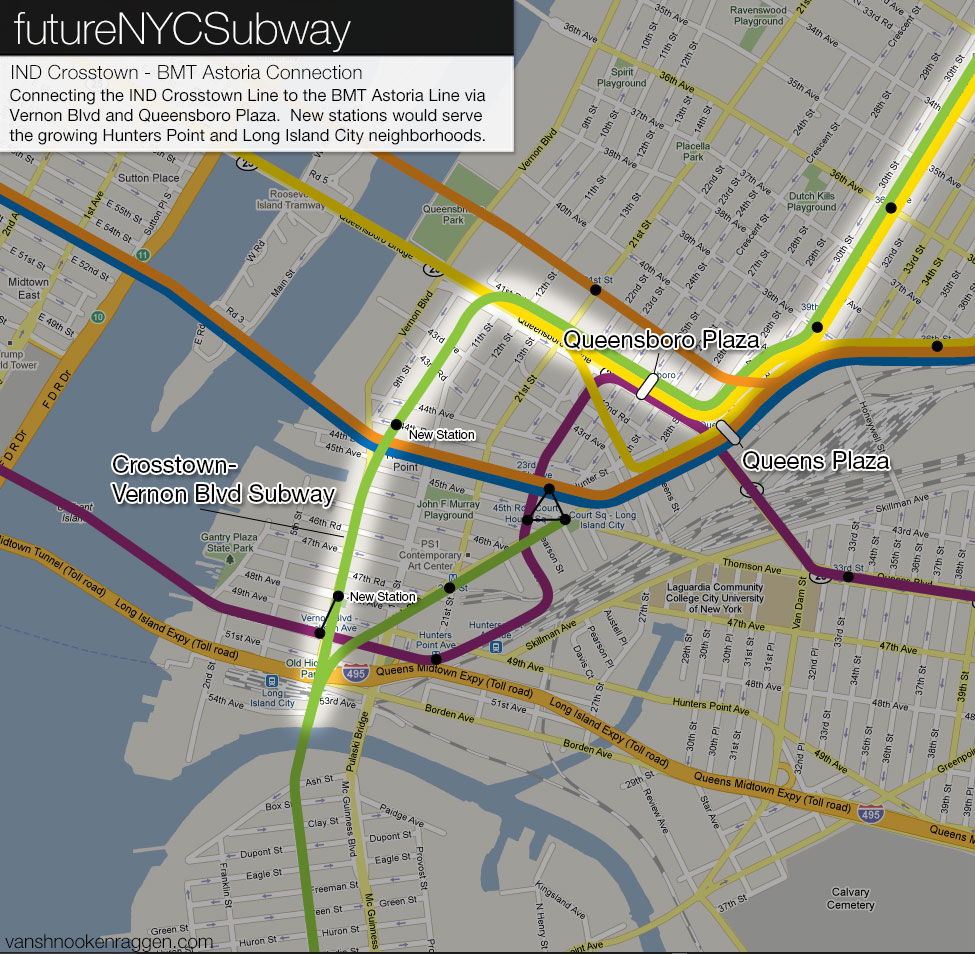

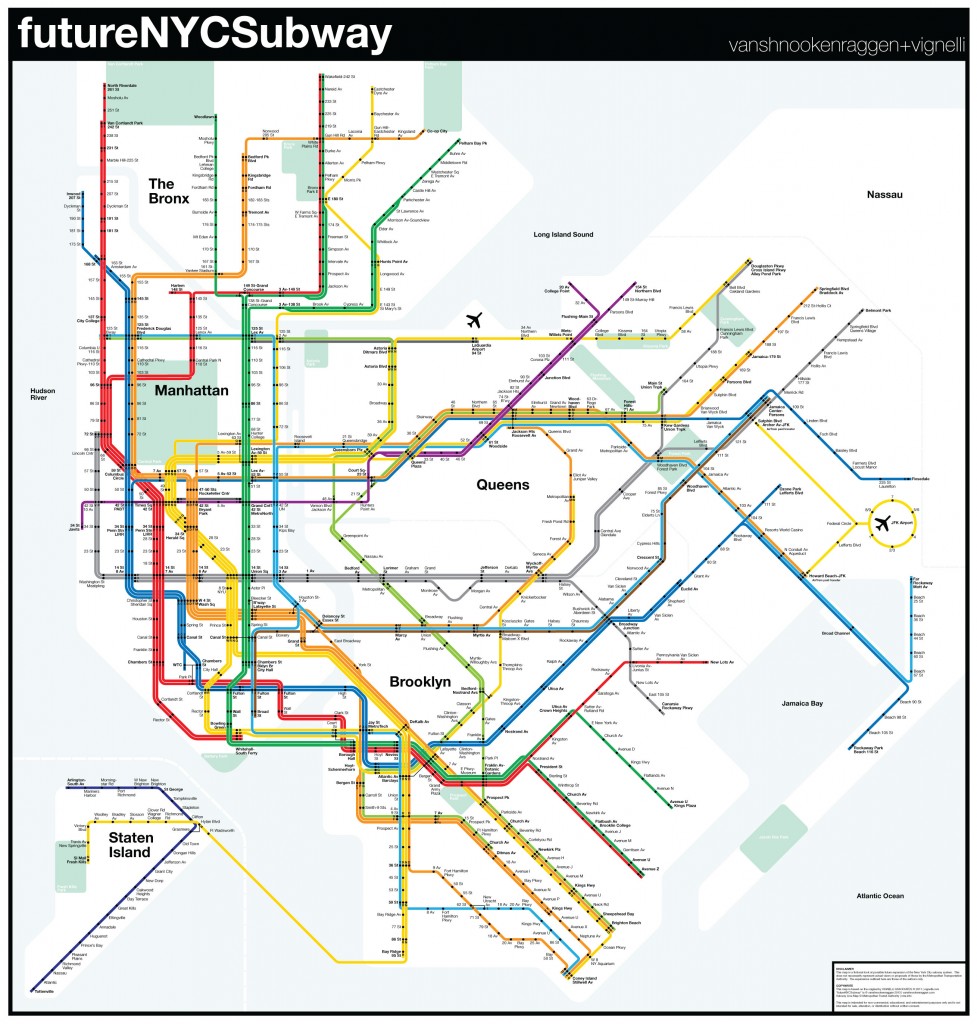
The futureNYCSubway: Expanding the Crosstown Line http://t.co/KbxvbuhVZD
I have a question, hopefully someone can answer it. How did he overlay subway lines over a map? I would love to do that because I have my own proposals I’d like to map.
I enjoy reading your plans, but I can’t help but feel that they are a bit out of touch with reality. In your post here, you label Triboro RX as ‘flashy’. I don’t think it’s flashy at all; it is a recognition that not everyone is headed towards the CBD. In fact, trips utilizing mass transit that aren’t headed to the CBD (whether midtown or Lower Manhattan) are growing fast; on Metro-North, reverse commuting is growing rapidly. Triboro RX accomplishes a few major things at once: One, it provides travel between the boroughs, a market that currently has little or no rail service. Two, in a few areas it roughly parallels existing, heavily used bus lines, and might reduce usage of these bus lines, while speeding the commute times. Three, it makes use of existing ROW, which would likely result in a substantial reduction in construction costs. I see a lot of your plans call of extensive tunneling of new subways, with seemingly no regard to cost. Triboro RX would add many miles of new mass transit line at a cost that the RPA estimated to be a fraction of the phase 1 SAS. TRX is a worthwhile proposal, one that really starts to make sense when you see the success of London’s Overground system.
What about a very modest proposal to get the G to Manhattan through a current underused tunnel and a proposed underused line to mid and downtown Manhattan? The 63st Tunnels and the southern half of the Second Ave. Subway.
The thing is the G shouldn’t ever go to Manhattan. As a circumferential line it is designed to distribute passengers to different radial lines. It works OK at this but this causes problems at the few transfer points (L at Lorimer, Court Sq, Hoyt-Schermerhorn). If the G tunnels were reconfigured to have more Manhattan bound trains (via other lines) then the G would be a piggy back service to Manhattan bound trains that would handle more of the load.
If the G were to be reconfigured to run through Manhattan where would it go? At present the only trunk line with extra capacity is the BMT Broadway Line but this gets full once the W is restored to Astoria after the Q is permanently rerouted up 2nd Ave. Then you’d have to wait for the 3rd and 4th phases of the Second Ave Subway to be built… so you are better off not even trying to send the G to Manhattan.
My name is Ahzeem I am impressed with how you came up with some good ideas I just wanted to know how did you create a subway map like that.